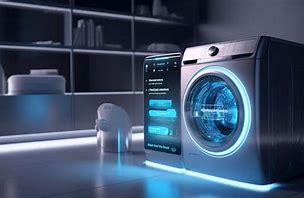AI-powered human washing machines are marvels of modern technology, designed to automate personal hygiene with efficiency and precision. These devices rely on sophisticated systems of sensors, motors, and AI algorithms to perform various functions, such as cleansing, rinsing, and drying. However, like any advanced machinery, they may encounter operational issues. One common concern is when the machine hums but fails to perform its spinning or cleaning functions.
This issue may stem from various causes, ranging from technical glitches to maintenance-related problems. Let’s explore why this might happen, how it can be resolved, and steps to prevent it in the future.
Understanding the Humming Sound
The humming sound in an AI-powered human washing machine typically comes from the motor or internal mechanisms attempting to engage a function, such as spinning or spraying water. This sound indicates that the machine is operational but unable to complete the intended task due to an underlying issue.

Possible Causes of Humming Without Spinning
1. Obstruction in the Mechanism
Foreign objects, such as small accessories or personal care items, may accidentally enter the machine. These can obstruct the spinning or cleaning mechanism, causing the motor to hum as it struggles to overcome the blockage.
2. Motor Overload
The motor in the washing machine may experience excessive strain due to overloading or extended use. This can cause it to hum without executing the required functions, as the system may shut down other components to protect itself.
3. Software or AI Malfunction
Since these machines are AI-driven, software glitches can occur. The AI may misinterpret sensor data or fail to initiate the correct sequence of operations, leading to incomplete cycles where the machine hums but doesn’t spin.
4. Insufficient Power Supply
AI-powered machines require consistent and adequate power to function correctly. Fluctuations in voltage or a weak power source can prevent the machine from operating at full capacity, causing it to hum without engaging other mechanisms.
5. Worn or Damaged Components
Over time, essential parts such as belts, gears, or bearings may wear out or become damaged. This can hinder the spinning mechanism while the motor continues to hum as it attempts to operate.
6. Calibration Issues
These machines often rely on precision calibration for their sensors and mechanical systems. If the calibration is off, the machine might detect incorrect inputs, leading to incomplete operations and the characteristic humming noise

How to Address the Issue
Step 1: Turn Off and Inspect
- Power down the machine and unplug it.
- Open accessible areas (following the manufacturer’s guidelines) to check for any visible obstructions or foreign objects.
Step 2: Reset the System
- Perform a system reset by turning the machine off, waiting for a few minutes, and then turning it back on.
- Refer to the user manual for specific reset instructions, as these vary by model.
Step 3: Check the Power Source
- Ensure the power supply is stable and meets the machine’s requirements.
- Avoid using extension cords that may not deliver adequate voltage.
Step 4: Run a Diagnostic Test
- Many AI-powered washing machines come with built-in diagnostic tools. Use these to identify specific error codes or problems.
- Follow the machine’s app or interface prompts for troubleshooting steps.
Step 5: Seek Professional Assistance
- If the problem persists, contact the manufacturer or a certified technician. Attempting to repair advanced components without expertise can cause further damage.
Preventing Future Issues
1. Regular Maintenance
Schedule periodic maintenance checks to ensure the machine remains in optimal condition. Clean and inspect moving parts, filters, and nozzles regularly.
2. Use Approved Products
Only use cleaning agents and accessories approved by the manufacturer. Incompatible products can cause clogs or damage.
3. Avoid Overloading
Respect the machine’s weight and usage guidelines to prevent strain on the motor and internal systems.
4. Update Software
Ensure the machine’s software and AI system are updated to the latest version. Manufacturers often release updates to fix bugs or improve performance.
5. Monitor Usage
Avoid using the machine continuously for extended periods. Allowing it to rest between sessions can prevent overheating and wear.
FAQs About AI-Powered Human Washing Machines
1. Why does my machine hum but not spin?
This could be due to obstructions, motor overload, software glitches, insufficient power supply, or worn components. Inspect the machine and troubleshoot based on the symptoms.
2. Can I fix the issue myself?
Basic issues like removing obstructions or resetting the system can often be resolved at home. However, for complex problems, it’s advisable to seek professional assistance.
3. How can I prevent this issue from recurring?
Regular maintenance, proper usage, and timely updates of the machine’s software can help prevent humming or operational failures in the future.
4. Is this problem covered under warranty?
Most manufacturers cover mechanical and software malfunctions under warranty, provided the machine has been used as instructed. Check your warranty terms for specifics.
5. Does the humming indicate permanent damage?
Not necessarily. Humming often signals a temporary issue, such as an obstruction or calibration error. However, ignoring it may lead to more severe damage over time.
The humming sound in an AI-powered human washing machine without accompanying spinning or cleaning actions is typically a sign of an underlying issue. Identifying the root cause—whether it’s a mechanical obstruction, software glitch, or power supply problem—is essential for timely resolution.
Regular maintenance, proper usage, and adherence to the manufacturer’s guidelines can help prevent this and other operational issues, ensuring that your machine remains a reliable and futuristic addition to your personal hygiene routine.
stay tuned for more updates about AI-related health techs


